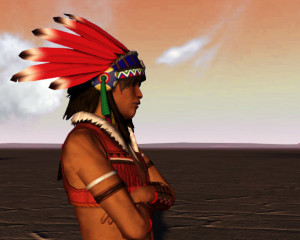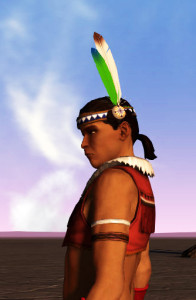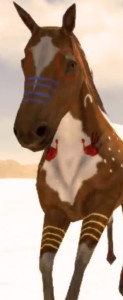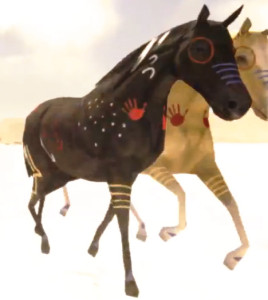Cultural Homage
by Bonzo, HSM guest contributor
Design elements from multiple cultures around the world are absorbed into the continuously expanding collective knowledge of contemporary life. Our media and pop culture exposes us to these foreign practices, and we absorb the elements we find aesthetically pleasing. But what we absorb frivolously is often sacred to the peoples from whom they originated.
Tattoos, piercings, body modification, hair styles, symbols, even clothing designs have more meaning than we are aware of when we absorb them as outsiders, just because they “look cool.” While there is nothing wrong with appreciating something for its aesthetics, it is important to keep perspective on their origins. Understanding that helps us to appreciate and respect those things which we find interesting.
There is a great deal of symbolism to cultural design elements, and without understanding them we can very easily misinterpret them. Symbols are by no means limited to the recesses of the past, nor have they been left behind in the wake of our modern civilization. We use symbols every day. While our symbols have become predominantly utilitarian to identify, to warn, to signals, or as corporate brands there is still a lot of symbolism used which hold sacred meaning and a form of tribal identification and even to mark rights of passage. We identify with a symbol of a country, a state, religion, a race, a birth signal, or birth year. Often when we see foreign cultural symbols we have a hard time recognizing them as being the same type of symbols we are familiar with. When absorbed into our media, and out of context, it loses meaning and it becomes frivolous.
 We are so accustomed to using the terminology “Native American” as a general reference to the indigenous people of North America before European colonization, that we forget we are not speaking of any one nation, tribe or culture. In fact we speak of many tribes and many cultures all with unique traditions, languages and beliefs. While some orthodoxy overlapped, they were still distinguishable by their own tight-knit communities. Some cultural practices have become so generalized we often assume they applied to all native tribes. For example the feathered headdress has become a generalized staple of Native American culture.
We are so accustomed to using the terminology “Native American” as a general reference to the indigenous people of North America before European colonization, that we forget we are not speaking of any one nation, tribe or culture. In fact we speak of many tribes and many cultures all with unique traditions, languages and beliefs. While some orthodoxy overlapped, they were still distinguishable by their own tight-knit communities. Some cultural practices have become so generalized we often assume they applied to all native tribes. For example the feathered headdress has become a generalized staple of Native American culture.
The Sioux is a general term for the people of the Sioux Nation which occupied a large portion of what is now the northern plain western states, consisting of three major distinct dialects. They are believed to be one of the first tribes to use the headdress. But tribal alliance did not entitle one to wear the headdress, as it was a symbol of power and influence among the tribe.
 The headdresses were also not just liberally granted to anyone, and were not earned all at once. Each feather had to be earned through acts of valor, with some of the tribes granting the first feather as a right of passage into adulthood. In some tribes the brave act alone only earned you the right to endure the ritual of fasting and meditation for several days to earn the feather. The color of the feathers predominantly consisted of indigenous bird species. Some tribes have applied meaning to specific bird feathers by how they perceived that particular species. Overall the color itself had little significance, but some specific bird feathers were coveted like the golden eagle or bald eagle feather. While some tribes granted the same honor to women, it was often restricted only to men. It was very rare for women in the plains tribes to be recognized with a headdress, and it was most commonly associated with the chief or leader of the tribe, and worn predominantly ceremoniously.
The headdresses were also not just liberally granted to anyone, and were not earned all at once. Each feather had to be earned through acts of valor, with some of the tribes granting the first feather as a right of passage into adulthood. In some tribes the brave act alone only earned you the right to endure the ritual of fasting and meditation for several days to earn the feather. The color of the feathers predominantly consisted of indigenous bird species. Some tribes have applied meaning to specific bird feathers by how they perceived that particular species. Overall the color itself had little significance, but some specific bird feathers were coveted like the golden eagle or bald eagle feather. While some tribes granted the same honor to women, it was often restricted only to men. It was very rare for women in the plains tribes to be recognized with a headdress, and it was most commonly associated with the chief or leader of the tribe, and worn predominantly ceremoniously.
The honor of a feather is not unlike earning a medal in our modern military. A decorated soldier has earned each and every one of their pins, stripes and medals through their actions. Thus they are not frivolous symbols, but insignia which represent duty, valor and an earned achievements that tell the story of that individuals accomplishments.
 The recent Lockwood Native American War Horse re-skins of the horse LMO are covered with painted symbols — but what do they mean? I must reiterate that symbolism isn’t general across the board, and not all tribes recognized the same symbols. But a general consensus is established on many of the symbols that were used on horses by native tribes. Each power symbol had its own meaning, and some told a story while others were intended to garner spiritual providence.
The recent Lockwood Native American War Horse re-skins of the horse LMO are covered with painted symbols — but what do they mean? I must reiterate that symbolism isn’t general across the board, and not all tribes recognized the same symbols. But a general consensus is established on many of the symbols that were used on horses by native tribes. Each power symbol had its own meaning, and some told a story while others were intended to garner spiritual providence.
The circle around the eyes and nostrils were intended to enhance a horses sensory acuity in sight and smell. Spots represented the eyes of many tribes involved in the war. Some tribes used alternating filled and hollowed spots to mark days and nights, which marked time and distance traveled. Stripes were intended to mark the number of war parties in which the horse and rider engaged. Hand prints represented human life and depending on its use it depicted a story pertaining to the fate of an individual. The left and right hand prints on the horse’s chest were earned after a horse had knocked down an enemy.
One of the heroic fables told among southern tribes was of the horse which returned to the tribe without its rider. One blood-red hand print marking the horse’s right side, which informed the tribe of the rider’s fate as a message of death. This fable may be related to the origin of the upside-down hand print. This was the highest honor bestowed on a horse by a warrior, and it was only used prior to a mission which meant almost certain death to the rider.
Hoof prints were often used to mark the number of horses captured in raids. Arrows were another significant symbol for Native Americans. The context in which they were used could mean war, peace, or a plead for defense, power or direction. The straight arrow used on a war horse was intended to point towards victory, but also as a blessing of protection. The crooked or fire arrow was intended to bring downfall to the enemy and as a blessing of power to the rider.
 Weather was perceived by Native Americans as something which wasn’t a natural phenomenon but a deliberate act of the gods. Thus it became a blessing or a curse, and evidence of the powers the gods wielded. The incomplete squares are sometimes interpreted as hoof prints, or as a representational prayer for hail or bad weather to fall on the enemy. Triangles were painted on all four hooves, which symbolized arrowheads to improve a horses speed and agility. While most of what I have read indicates the thunder stripes were normally painted on the front legs to please the god of war, it is unclear if they were symbolically equivalent in the rear legs as well. But they represented lightning bolts to bring power and speed to the horse.
Weather was perceived by Native Americans as something which wasn’t a natural phenomenon but a deliberate act of the gods. Thus it became a blessing or a curse, and evidence of the powers the gods wielded. The incomplete squares are sometimes interpreted as hoof prints, or as a representational prayer for hail or bad weather to fall on the enemy. Triangles were painted on all four hooves, which symbolized arrowheads to improve a horses speed and agility. While most of what I have read indicates the thunder stripes were normally painted on the front legs to please the god of war, it is unclear if they were symbolically equivalent in the rear legs as well. But they represented lightning bolts to bring power and speed to the horse.
Colors also had significance in war paint. Red was often used to paint a horse’s scars as a badge of honor. It symbolized war and strength, and a depiction of energy and power. Black was sometimes applied to the horse after victory and before returning to the camp. White contextually represented either peace or mourning. Blue was a color of wisdom, experience and confidence. Yellow depicted death, and on a war horse or the rider symbolized the willingness to fight to the death. Green represented endurance, and sometimes was seen as a healing color and believed to improve vision. So the circles around the eyes were sometimes painted in green.
The diversity of tribes and interpretation of symbols means power symbols could have several meanings. Power symbols existed for different needs relevant to the communities of Native Americans. War required its own symbols, as did hunting, and agricultural success or just the community’s well being. Symbols have meaning, they exist for a reason and on sight they told a story or warned. While their needs have predominantly become archaic and part of cultural spiritual beliefs, they have not become insignificant nor frivolous. Understanding that is important to respecting the cool designs we take for granted and turn simple decorations into the respectful cultural homage intended.
Share
| Tweet |


 Twitter
Twitter